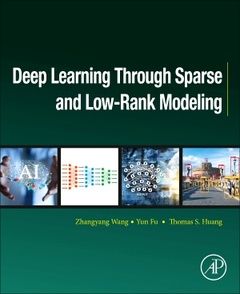Deep Learning through Sparse and Low-Rank Modeling Computer Vision and Pattern Recognition Series
Auteurs : Wang Zhangyang, Fu Yun, Huang Thomas S.

Deep Learning through Sparse Representation and Low-Rank Modeling bridges classical sparse and low rank models?those that emphasize problem-specific Interpretability?with recent deep network models that have enabled a larger learning capacity and better utilization of Big Data. It shows how the toolkit of deep learning is closely tied with the sparse/low rank methods and algorithms, providing a rich variety of theoretical and analytic tools to guide the design and interpretation of deep learning models. The development of the theory and models is supported by a wide variety of applications in computer vision, machine learning, signal processing, and data mining.
This book will be highly useful for researchers, graduate students and practitioners working in the fields of computer vision, machine learning, signal processing, optimization and statistics.
Dr. Fu is an interdisciplinary faculty member affiliated with College of Engineering and the College of Computer and Information Science at Northeastern University. He received the B.Eng. degree in information engineering and the M.Eng. degree in pattern recognition and intelligence systems from Xi'an Jiaotong University, China, respectively, and the M.S. degree in statistics and the Ph.D. degree in electrical and computer engineering from the University of Illinois at Urbana-Champaign, respectively.
Dr. Fu's research interests are Interdisciplinary research in Machine Learning and Computational Intelligence, Social Media Analytics, Human-Computer Interaction, and Cyber-Physical Systems. He has extensive publications in leading journals, books/book chapters and international conferences/workshops.
Thomas S. Huang received his B.S. Degree in Electrical Engineering from National Taiwan University, Taipei, Taiwan, China; and his M.S. and Sc.D. Degrees in Electrical Engineering from the Massachusetts Institute of Technology, Cambridge, Massachusetts. He was on the Faculty of t
- Combines classical sparse and low-rank models and algorithms with the latest advances in deep learning networks
- Shows how the structure and algorithms of sparse and low-rank methods improves the performance and interpretability of Deep Learning models
- Provides tactics on how to build and apply customized deep learning models for various applications
Date de parution : 04-2019
Ouvrage de 296 p.
19x23.3 cm
Thèmes de Deep Learning through Sparse and Low-Rank Modeling :
Mots-clés :
3D image; Action recognition; Architecture; Autoencoder; Bi-level optimization; Clustering; Compressive sensing; Deep learning; Dictionary learning; Domain adaptation; Fashion; Hyperspectral image classification; Image dehazing; Image super-resolution; Locality constraint; Low rank; Lung cancer; Machine learning; Manga; Manifold; Marginalized denoising auto-encoder; Multiview learning; Neural network; Neuron; Pooling; Restoration and enhancement; RGB-D action; Semisupervised learning; Sparse approximation; Sparse coding; Sparsity; Spatial Laplacian regularization; Speech denoising; Style classification; Task-driven dictionary learning



